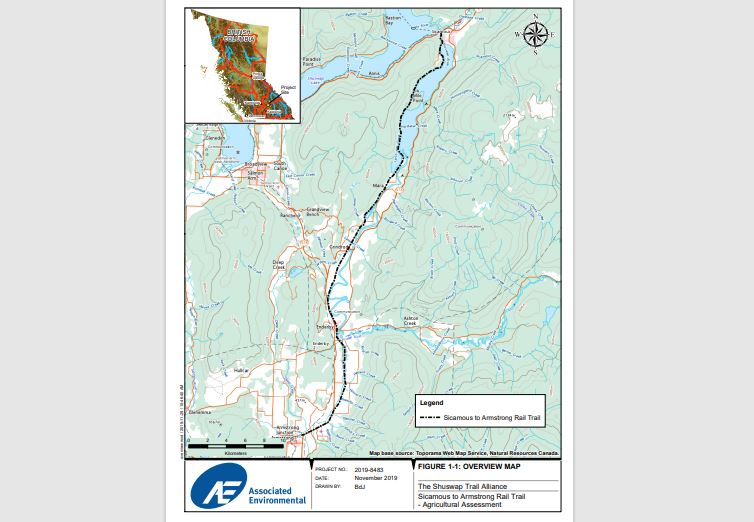The BC Agricultural Land Commission (ALC) has accepted arguments by several local governments to allow sections of a 51-km former CP rail line in the North Okanagan and Shuswap to be taken out of the farmland reserve.

“It is another important milestone in the development of the Shuswap North Okanagan Rail Trail corridor between Sicamous and Armstrong within Splatsin territory of the Secwépemc Nation,” said a release from the Phil McIntyre-Paul with the Shuswap Trail Alliance.
Local government purchased the former rail line in the last five years with the plan of developing the corridor into a pedestrian and bike path, similar to the 47-km trail that now joins Kelowna and Vernon.
There are 47 property titles along the trail north of Armstrong that are owned by the Splatsin First Nation, Regional District of North Okanagan and Columbia Shuswap Regional District.
While properties along 35 km of the proposed trail are within the Agriculture Land Reserve (ALR), they have never been actively used for agriculture, according to the ALC decision.

Get breaking National news
The rail line also predates creation of the ALR by several decades.
“The 51-km corridor is to be converted into a safe and functional trail for four season, non-motorized recreational use by pedestrians and cyclists,” according to ALC documents on the proposed trail.
“The vision of inter-jurisdictional collaboration is, among other goals, to protect the environmental, agricultural and cultural values.”
It’s estimated the trail will cost $17 million to build, with fundraising well underway.
Another 169 parcels of land (approximately 1,733 hectares) adjacent or close to the rail trail have the potential to be affected by public use of the trail, with 75 per cent of the land being actively used for agriculture, stated the ALC.
Rail trail proponents have worked out tentative agreements with property owners so that farm equipment can cross the trail, water lines are uninterrupted by construction, a dogs-on-leash policy will be created and privacy issues will be addressed, according to the Alliance.
- Ukraine bans Telegram app on state-issued devices, citing security fears
- Donald Trump claims B.C.’s ‘very large faucet’ could help California’s water woes
- Canada must speed up progress to hit its 2030 emissions target: report
- U.S. TikTok ban case pits free speech vs. national security. Which will win?
“It has been a particularly rewarding opportunity to meet with so many of the region’s agricultural community,” McIntyre-Paul said. “The rail trail presents a very unique opportunity to strengthen awareness and support of our local farming families and connect people more closely to the importance of local food production.”
The trail runs along the west shores of Mara Lake, south of Sicamous.
“The trail will not exceed a 5 per cent grade and will have a minimum of 3 metre width,” according to the ALC. “At this time, the plan is to have an aggregate surface.”
Following its decision, the ALC said trail construction can begin once a detailed design of highway crossings are finalized.
“Construction is expected to continue for two years, with construction typically from March to mid-November. Access points and locations of amenities are being finalized by the Committee, with input from the public,” said the ALC decision.
“It is the intent of the Committee to direct people to communities rather than rural areas to access the trail, except for areas that currently attract recreational users to park. These potential problem areas are being considered and appropriate parking locations will be designated.”
The Alliance plans to take numerous steps to continue working with private land owners along the trail to mitigate conflict with users.
“Once built, monitoring and feedback from local farms will allow further solutions to be developed where a concern or conflict is identified,” McIntyre-Paul said.
The future plan is to continue acquiring land between Armstrong and Vernon as well as West Kelowna and Osoyoos to create a continuous 200-plus-km trail.
A fundraising campaign to help build the north end of the trail can be accessed at www.ShuswapNorthOkanaganRailTrail.ca.








Comments